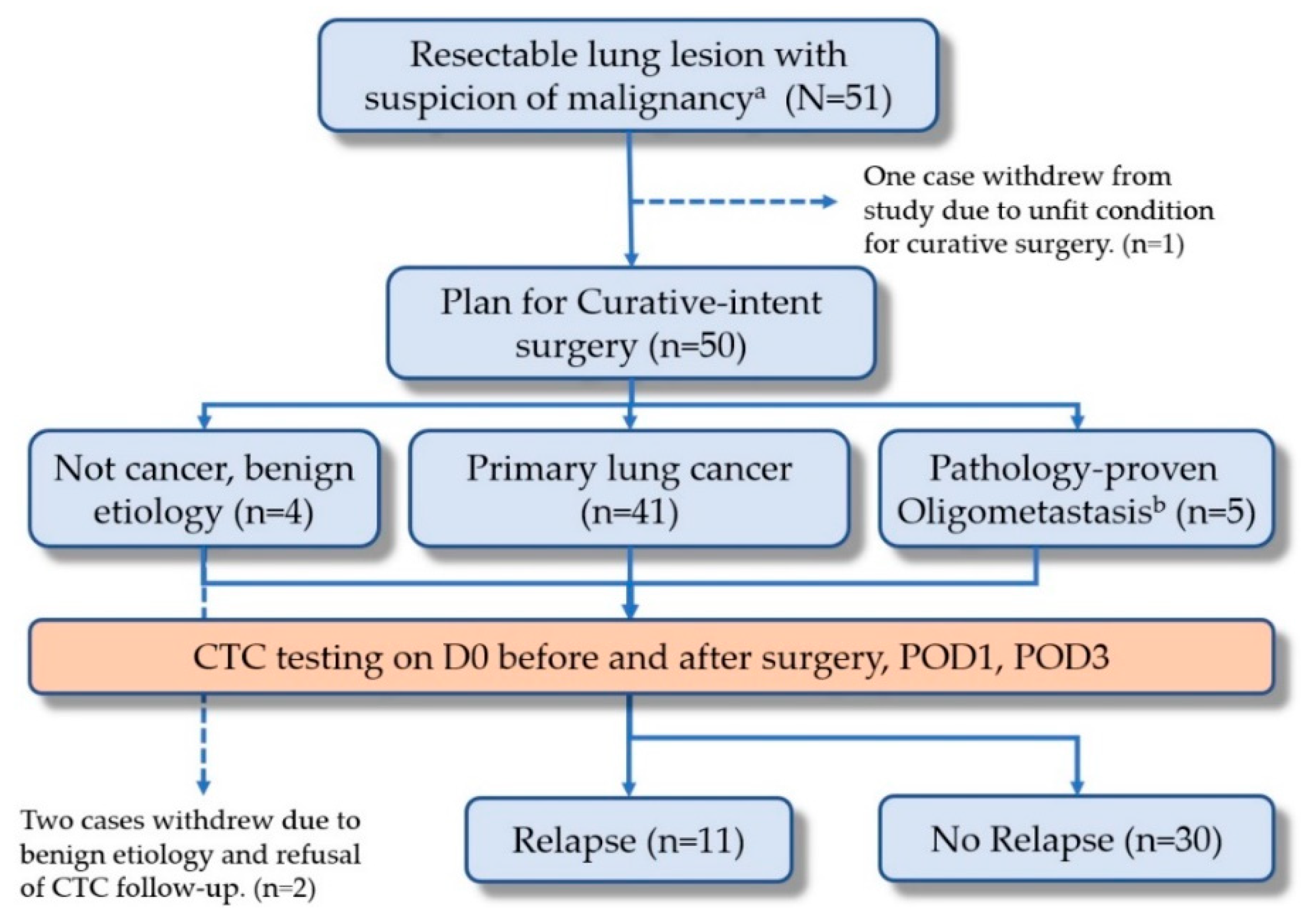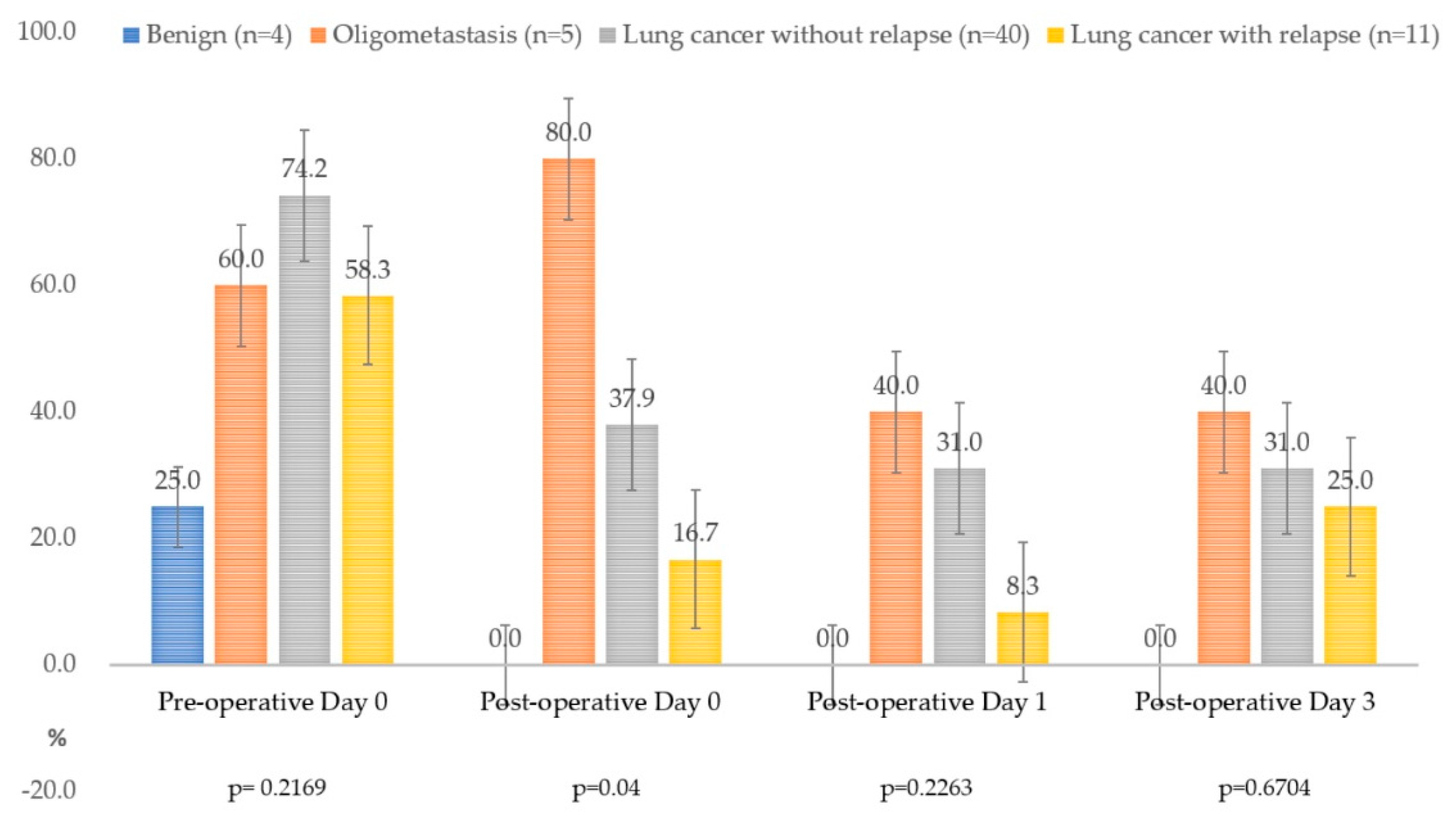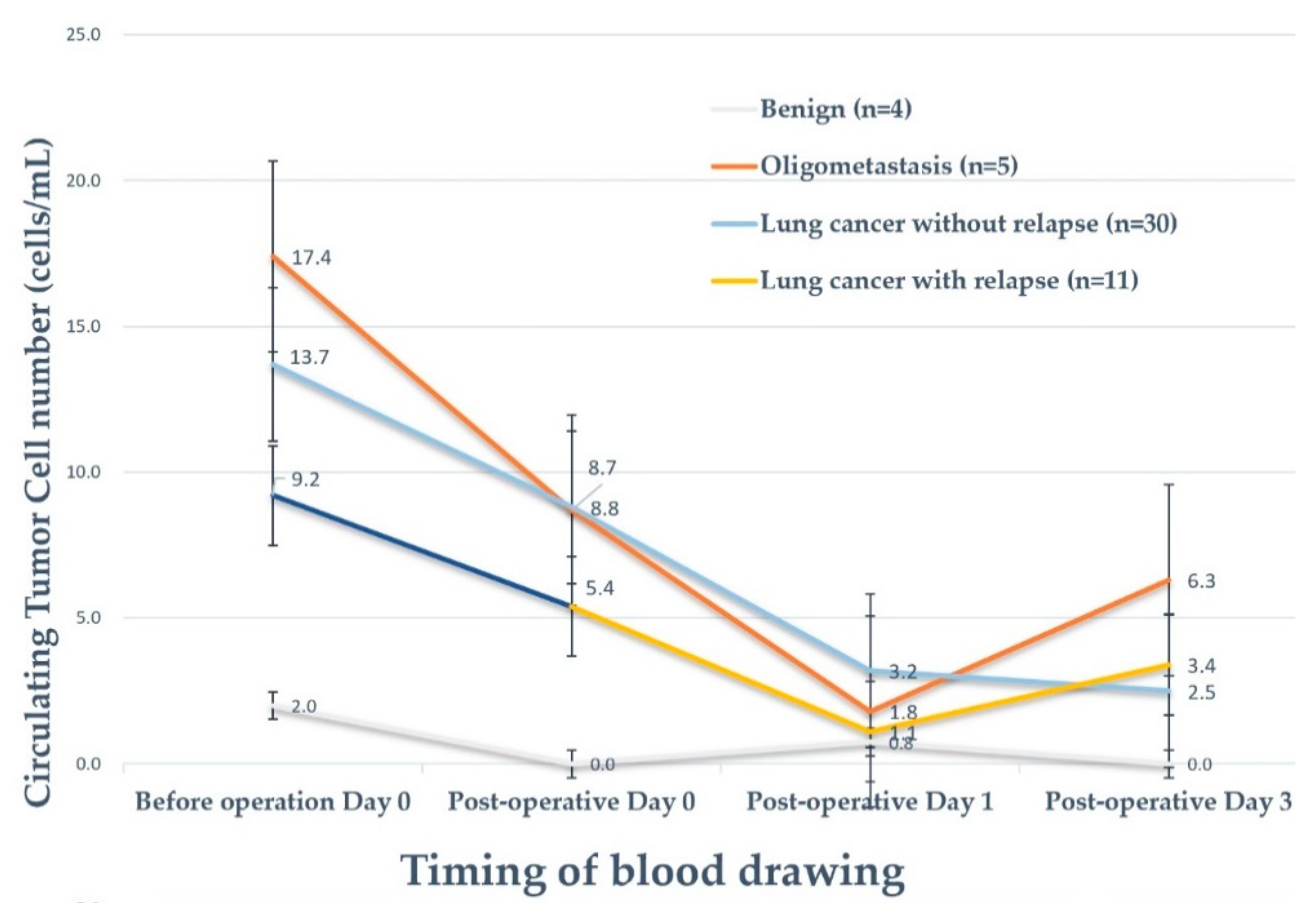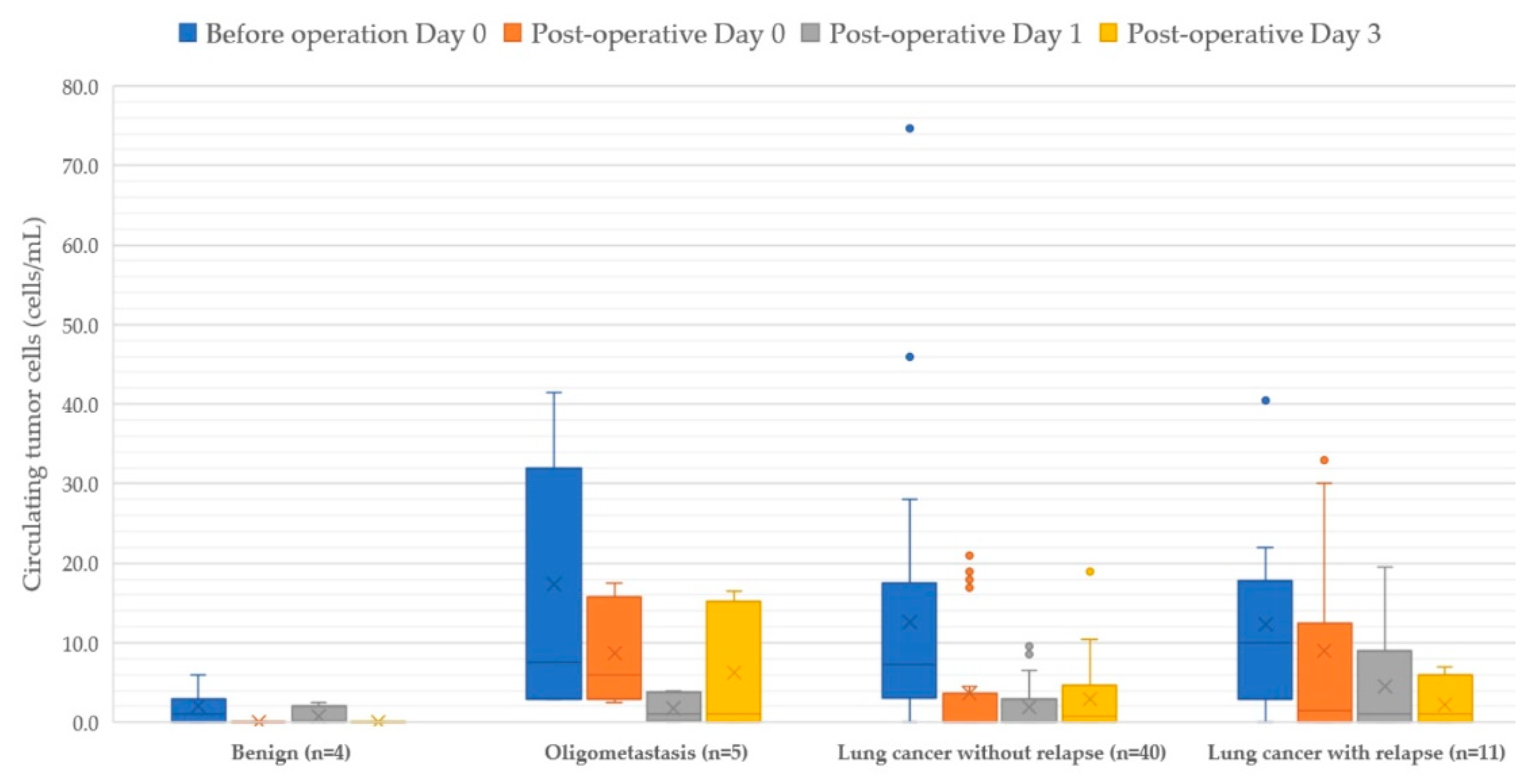Circulating Tumor Cells as a Tool of Minimal Residual Disease Can Predict Lung Cancer Recurrence: A longitudinal, Prospective Trial
Abstract
1. Introduction
2. Materials and Methods
2.1. Patients and Criteria of Enrollment
2.2. Pre-Operative Evaluation
2.3. Operational Methods and Post-Operative Treatment
2.4. Surveillance and Management of Suspicious Relapse
2.5. Circulating Tumor Cell Sampling, Identification, and Quality Controls
2.6. Statistical Analysis
3. Results
3.1. Patient Enrollment
3.2. Circulating Tumor Cell Counts
3.3. Subgroups Based on Pathologic Findings and Cancer Outcome (Cancer Relapse)
3.4. The Positivity of Circulating Tumor Cell Detection in Different Clinical Conditions
3.5. Mixed Model Repeated Measures Analysis for Dynamic Changes of Circulating Tumor Cell Counts
4. Discussion
5. Conclusions
Supplementary Materials
Author Contributions
Funding
Acknowledgments
Conflicts of Interest
Abbreviations
| C/T ratio | consolidation tumor ratio |
| CEA | carcinoembryonic antigen; |
| CT | computed tomography |
| CTCs | circulating tumor cells |
| ctDNA | circulating tumor DNA |
| CV | coefficient of variation |
| ECOG | Eastern Cooperative Oncology Group |
| EMT | epithelial-mesenchymal transition |
| IRB | Institutional Review Board |
| MMRM | Mixed model repeated measures; |
| MRD | minimal residual disease |
| MRI | Magnetic resonance imaging |
| PET | positron emission tomography |
| POD | postoperative day |
| SCC | squamous cell carcinoma; |
| SD | standard deviation |
| TTF-1 | thyroid transcription factor-1 |
References
- Torre, L.A.; Siegel, R.L.; Ward, E.M.; Jemal, A. Global cancer incidence and mortality rates and trends—an update. Cancer Epidemiol. Prev. Biomark. 2016, 25, 16–27. [Google Scholar] [CrossRef] [PubMed]
- National Comprehensive Cancer Network. Non-Small Cell Lung Cancer (Version 2. 2020). 2019. Available online: https://www.nccn.org/professionals/physician_gls/default.aspx (accessed on 6 March 2020).
- Wu, C.F.; Wu, C.Y.; Fu, J.Y.; Wang, C.W.; Liu, Y.H.; Hsieh, M.J.; Wu, Y.C. Prognostic value of metastatic N1 lymph node ratio and angiolymphatic invasion in patients with pathologic stage IIA non-small cell lung cancer. Medicine 2014, 93, e102. [Google Scholar] [CrossRef] [PubMed]
- Wu, C.F.; Fu, J.Y.; Yeh, C.J.; Liu, Y.H.; Hsieh, M.J.; Wu, Y.C.; Wu, C.Y.; Tsai, Y.H.; Chou, W.C. Recurrence Risk Factors Analysis for Stage I Non-small Cell Lung Cancer. Medicine 2015, 94, e1337. [Google Scholar] [CrossRef] [PubMed]
- Wu, C.-Y.; Fu, J.-Y.; Wu, C.-F.; Hsieh, M.-J.; Liu, Y.-H.; Wu, Y.-C.; Yang, C.-T.; Tsai, Y.-H. Survival Prediction Model Using Clinico-Pathologic Characteristics for Nonsmall Cell Lung Cancer Patients After Curative Resection. Medicine 2015, 94, 45. [Google Scholar] [CrossRef] [PubMed]
- Hsieh, C.P.; Hsieh, M.J.; Wu, C.F.; Fu, J.Y.; Liu, Y.H.; Wu, Y.C.; Yang, C.T.; Wu, C.Y. Prognostic factors in non-small cell lung cancer patients who received neoadjuvant therapy and curative resection. J. Thorac. Dis. 2016, 8, 1477–1486. [Google Scholar] [CrossRef] [PubMed]
- Dahlbom, M.; Hoffman, E.J.; Hoh, C.K.; Schiepers, C.; Rosenqvist, G.; Hawkins, R.A.; Phelps, M.E. Whole-body positron emission tomography: Part I. Methods and performance characteristics. J. Nucl. Med. 1992, 33, 1191–1199. [Google Scholar]
- Nolop, K.B.; Rhodes, C.G.; Brudin, L.H.; Beaney, R.P.; Krausz, T.; Jones, T.; Hughes, J.M. Glucose utilization in vivo by human pulmonary neoplasms. Cancer 1987, 60, 2682–2689. [Google Scholar] [CrossRef]
- Brown, R.S.; Leung, J.Y.; Kison, P.V.; Zasadny, K.R.; Flint, A.; Wahl, R.L. Glucose transporters and FDG uptake in untreated primary human non-small cell lung cancer. J. Nucl. Med. 1999, 40, 556–565. [Google Scholar]
- Pieterman, R.M.; van Putten, J.W.; Meuzelaar, J.J.; Mooyaart, E.L.; Vaalburg, W.; Koëter, G.H.; Fidler, V.; Pruim, J.; Groen, H.J. Preoperative staging of non–small-cell lung cancer with positron-emission tomography. N. Engl. J. Med. 2000, 343, 254–261. [Google Scholar] [CrossRef]
- Funama, Y.; Awai, K.; Liu, D.; Oda, S.; Yanaga, Y.; Nakaura, T.; Kawanaka, K.; Shimamura, M.; Yamashita, Y. Detection of nodules showing ground-glass opacity in the lungs at low-dose multidetector computed tomography: Phantom and clinical study. J. Comput. Assist. Tomogr. 2009, 33, 49–53. [Google Scholar] [CrossRef]
- Boedeker, K.L.; Cooper, V.N.; McNitt-Gray, M.F. Application of the noise power spectrum in modern diagnostic MDCT: Part I. Measurement of noise power spectra and noise equivalent quanta. Phys. Med. Biol. 2007, 52, 4027–4046. [Google Scholar] [CrossRef] [PubMed]
- Schwartz, L.H.; Litière, S.; de Vries, E.; Ford, R.; Gwyther, S.; Mandrekar, S.; Shankar, L.; Bogaerts, J.; Chen, A.; Dancey, J. RECIST 1.1—Update and clarification: From the RECIST committee. Eur. J. Cancer 2016, 62, 132–137. [Google Scholar] [CrossRef] [PubMed]
- Bueno, J.; Landeras, L.; Chung, J.H. Updated Fleischner Society Guidelines for Managing Incidental Pulmonary Nodules: Common Questions and Challenging Scenarios. Radiographics 2018, 38, 1337–1350. [Google Scholar] [CrossRef] [PubMed]
- Gupta, G.P.; Massague, J. Cancer metastasis: Building a framework. Cell 2006, 127, 679–695. [Google Scholar] [CrossRef] [PubMed]
- Fidler, I.J. The pathogenesis of cancer metastasis: The ‘seed and soil’ hypothesis revisited. Nat. Rev. Cancer 2003, 3, 453. [Google Scholar] [CrossRef] [PubMed]
- Masuda, T.; Hayashi, N.; Iguchi, T.; Ito, S.; Eguchi, H.; Mimori, K. Clinical and biological significance of circulating tumor cells in cancer. Mol. Oncol. 2016, 10, 408–417. [Google Scholar] [CrossRef]
- Young, R.; Pailler, E.; Billiot, F.; Drusch, F.; Barthelemy, A.; Oulhen, M.; Besse, B.; Soria, J.C.; Farace, F.; Vielh, P. Circulating tumor cells in lung cancer. Acta Cytol. 2012, 56, 655–660. [Google Scholar] [CrossRef]
- Tognela, A.; Spring, K.J.; Becker, T.; Caixeiro, N.J.; Bray, V.J.; Yip, P.Y.; Chua, W.; Lim, S.H.; de Souza, P. Predictive and prognostic value of circulating tumor cell detection in lung cancer: A clinician’s perspective. Crit. Rev. Oncol. Hematol. 2015, 93, 90–102. [Google Scholar] [CrossRef]
- Tanaka, F.; Yoneda, K.; Kondo, N.; Hashimoto, M.; Takuwa, T.; Matsumoto, S.; Okumura, Y.; Rahman, S.; Tsubota, N.; Tsujimura, T. Circulating tumor cell as a diagnostic marker in primary lung cancer. Clin. Cancer Res. 2009, 15, 6980–6986. [Google Scholar] [CrossRef]
- O’Flaherty, J.D.; Gray, S.; Richard, D.; Fennell, D.; O’Leary, J.J.; Blackhall, F.H.; O’Byrne, K.J. Circulating tumour cells, their role in metastasis and their clinical utility in lung cancer. Lung Cancer 2012, 76, 19–25. [Google Scholar] [CrossRef]
- Yoon, S.O.; Kim, Y.T.; Jung, K.C.; Jeon, Y.K.; Kim, B.H.; Kim, C.W. TTF-1 mRNA-positive circulating tumor cells in the peripheral blood predict poor prognosis in surgically resected non-small cell lung cancer patients. Lung Cancer 2011, 71, 209–216. [Google Scholar] [CrossRef] [PubMed]
- Nieva, J.; Wendel, M.; Luttgen, M.S.; Marrinucci, D.; Bazhenova, L.; Kolatkar, A.; Santala, R.; Whittenberger, B.; Burke, J.; Torrey, M.; et al. High-definition imaging of circulating tumor cells and associated cellular events in non-small cell lung cancer patients: A longitudinal analysis. Phys. Biol. 2012, 9, 016004. [Google Scholar] [CrossRef] [PubMed][Green Version]
- Maheswaran, S.; Sequist, L.V.; Nagrath, S.; Ulkus, L.; Brannigan, B.; Collura, C.V.; Inserra, E.; Diederichs, S.; Iafrate, A.J.; Bell, D.W.; et al. Detection of mutations in EGFR in circulating lung-cancer cells. N. Engl. J. Med. 2008, 359, 366–377. [Google Scholar] [CrossRef] [PubMed]
- Carbone, D.P.; Salmon, J.S.; Billheimer, D.; Chen, H.; Sandler, A.; Roder, H.; Roder, J.; Tsypin, M.; Herbst, R.S.; Tsao, A.S.; et al. VeriStrat classifier for survival and time to progression in non-small cell lung cancer (NSCLC) patients treated with erlotinib and bevacizumab. Lung Cancer 2010, 69, 337–340. [Google Scholar] [CrossRef] [PubMed][Green Version]
- Chen, Y.Y.; Xu, G.B. Effect of circulating tumor cells combined with negative enrichment and CD45-FISH identification in diagnosis, therapy monitoring and prognosis of primary lung cancer. Med. Oncol. 2014, 31, 240. [Google Scholar] [CrossRef]
- Mascalchi, M.; Falchini, M.; Maddau, C.; Salvianti, F.; Nistri, M.; Bertelli, E.; Sali, L.; Zuccherelli, S.; Vella, A.; Matucci, M. Prevalence and number of circulating tumour cells and microemboli at diagnosis of advanced NSCLC. J. Cancer Res. Clin. Oncol. 2016, 142, 195–200. [Google Scholar] [CrossRef] [PubMed]
- Su, P.-J.; Wu, M.-H.; Wang, H.-M.; Lee, C.-L.; Huang, W.-K.; Wu, C.-E.; Chang, H.-K.; Chao, Y.-K.; Tseng, C.-K.; Chiu, T.-K. Circulating tumour cells as an independent prognostic factor in patients with advanced oesophageal squamous cell carcinoma undergoing chemoradiotherapy. Sci. Rep. 2016, 6, 31423. [Google Scholar] [CrossRef] [PubMed]
- Thornblade, L.W.; Mulligan, M.S.; Odem-Davis, K.; Hwang, B.; Waworuntu, R.L.; Wolff, E.M.; Kessler, L.; Wood, D.E.; Farjah, F. Challenges in Predicting Recurrence After Resection of Node-Negative Non-Small Cell Lung Cancer. Ann. Thorac. Surg. 2018, 106, 1460–1467. [Google Scholar] [CrossRef] [PubMed]
- Okumura, Y.; Tanaka, F.; Yoneda, K.; Hashimoto, M.; Takuwa, T.; Kondo, N.; Hasegawa, S. Circulating tumor cells in pulmonary venous blood of primary lung cancer patients. Ann. Thorac. Surg. 2009, 87, 1669–1675. [Google Scholar] [CrossRef] [PubMed]
- Dziedzic, D.A.; Rudzinski, P.; Langfort, R.; Orlowski, T.; Group, P.L.C.S. Risk Factors for Local and Distant Recurrence After Surgical Treatment in Patients with Non–Small-Cell Lung Cancer. Clin. Lung Cancer 2016, 17, e157–e167. [Google Scholar] [CrossRef] [PubMed]
- Godoy, M.C.; Naidich, D.P. Subsolid pulmonary nodules and the spectrum of peripheral adenocarcinomas of the lung: Recommended interim guidelines for assessment and management. Radiology 2009, 253, 606–622. [Google Scholar] [CrossRef] [PubMed]
- Yu, Y.-H.; Liao, C.-C.; Hsu, W.-H.; Chen, H.-J.; Liao, W.-C.; Muo, C.-H.; Sung, F.-C.; Chen, C.-Y. Increased lung cancer risk among patients with pulmonary tuberculosis: A population cohort study. J. Thorac. Oncol. 2011, 6, 32–37. [Google Scholar] [CrossRef] [PubMed]
- Luo, Y.-H.; Wu, C.-H.; Wu, W.-S.; Huang, C.-Y.; Su, W.-J.; Tsai, C.-M.; Lee, Y.-C.; Perng, R.-P.; Chen, Y.-M. Association between tumor epidermal growth factor receptor mutation and pulmonary tuberculosis in patients with adenocarcinoma of the lungs. J. Thorac. Oncol. 2012, 7, 299–305. [Google Scholar] [CrossRef] [PubMed]
- Park, C.M.; Goo, J.M.; Kim, T.J.; Lee, H.J.; Lee, K.W.; Lee, C.H.; Kim, Y.T.; Kim, K.G.; Lee, H.Y.; Park, E.-A. Pulmonary nodular ground-glass opacities in patients with extrapulmonary cancers: What is their clinical significance and how can we determine whether they are malignant or benign lesions? Chest 2008, 133, 1402–1409. [Google Scholar] [CrossRef] [PubMed]
- Hashimoto, M.; Tanaka, F.; Yoneda, K.; Takuwa, T.; Matsumoto, S.; Okumura, Y.; Kondo, N.; Tsubota, N.; Tsujimura, T.; Tabata, C.; et al. Significant increase in circulating tumour cells in pulmonary venous blood during surgical manipulation in patients with primary lung cancer. Interact. Cardiovasc. Thorac. Surg. 2014, 18, 775–783. [Google Scholar] [CrossRef] [PubMed]
- Crosbie, P.A.; Shah, R.; Krysiak, P.; Zhou, C.; Morris, K.; Tugwood, J.; Booton, R.; Blackhall, F.; Dive, C. Circulating Tumor Cells Detected in the Tumor-Draining Pulmonary Vein Are Associated with Disease Recurrence after Surgical Resection of NSCLC. J. Thorac. Oncol. 2016, 11, 1793–1797. [Google Scholar] [CrossRef]
- Reddy, R.M.; Murlidhar, V.; Zhao, L.; Grabauskiene, S.; Zhang, Z.; Ramnath, N.; Lin, J.; Chang, A.C.; Carrott, P.; Lynch, W. Pulmonary venous blood sampling significantly increases the yield of circulating tumor cells in early-stage lung cancer. J. Thorac. Cardiovasc. Surg. 2016, 151, 852–858. [Google Scholar] [CrossRef]
- Sakurai, F.; Narii, N.; Tomita, K.; Togo, S.; Takahashi, K.; Machitani, M.; Tachibana, M.; Ouchi, M.; Katagiri, N.; Urata, Y.; et al. Efficient detection of human circulating tumor cells without significant production of false-positive cells by a novel conditionally replicating adenovirus. Mol. Ther. Methods Clin. Dev. 2016, 3, 16001. [Google Scholar] [CrossRef][Green Version]
- Kolbl, A.C.; Jeschke, U.; Andergassen, U. The Significance of Epithelial-to-Mesenchymal Transition for Circulating Tumor Cells. Int. J. Mol. Sci. 2016, 17, 1308. [Google Scholar] [CrossRef]
- Koebel, C.M.; Vermi, W.; Swann, J.B.; Zerafa, N.; Rodig, S.J.; Old, L.J.; Smyth, M.J.; Schreiber, R.D. Adaptive immunity maintains occult cancer in an equilibrium state. Nature 2007, 450, 903–907. [Google Scholar] [CrossRef]
- De Rubis, G.; Rajeev Krishnan, S.; Bebawy, M. Liquid Biopsies in Cancer Diagnosis, Monitoring, and Prognosis. Trends Pharmacol. Sci. 2019, 40, 172–186. [Google Scholar] [CrossRef] [PubMed]
- Jahr, S.; Hentze, H.; Englisch, S.; Hardt, D.; Fackelmayer, F.O.; Hesch, R.D.; Knippers, R. DNA fragments in the blood plasma of cancer patients: Quantitations and evidence for their origin from apoptotic and necrotic cells. Cancer Res. 2001, 61, 1659–1665. [Google Scholar] [PubMed]
- Lo, Y.M.; Zhang, J.; Leung, T.N.; Lau, T.K.; Chang, A.M.; Hjelm, N.M. Rapid clearance of fetal DNA from maternal plasma. Am. J. Hum. Genet. 1999, 64, 18–24. [Google Scholar] [CrossRef]
- Lathia, J.D.; Liu, H. Overview of Cancer Stem Cells and Stemness for Community Oncologists. Target. Oncol. 2017, 12, 387–399. [Google Scholar] [CrossRef] [PubMed]
- Chaudhuri, A.A.; Chabon, J.J.; Lovejoy, A.F.; Newman, A.M.; Stehr, H.; Azad, T.D.; Khodadoust, M.S.; Esfahani, M.S.; Liu, C.L.; Zhou, L.; et al. Early Detection of Molecular Residual Disease in Localized Lung Cancer by Circulating Tumor DNA Profiling. Cancer Discov. 2017, 7, 1394–1403. [Google Scholar] [CrossRef] [PubMed]
- Comino-Mendez, I.; Turner, N. Predicting Relapse with Circulating Tumor DNA Analysis in Lung Cancer. Cancer Discov. 2017, 7, 1368–1370. [Google Scholar] [CrossRef] [PubMed]




| Clinical Characteristics | N | Range/% |
|---|---|---|
| Age, median (years) | 63.0 | 31.0–91.0 |
| Sex, male/female | 26/24 | 52.0%/48.0% |
| ECOG performance status | ||
| 0 | 49 | 98.0% |
| 1 | 1 | 2.0% |
| Smoking history | ||
| Never | 34 | 68.0% |
| Former or Current | 16 | 32.0% |
| Operational method | ||
| Lobectomy + mediastinal lymph node dissection | 29 | 58.0% |
| Segmentectomy + mediastinal lymph node dissection | 17 | 34.0% |
| Wedge resection + mediastinal lymph node sampling | 4 | 8.0% |
| Pre-operative lab data | Value | Reference values |
| CEA (ng/mL), reference range | 2.8 ± 3.2 | < 5.0 |
| SCC (ng/mL), reference range | 1.0 ± 0.6 | < 2.5 |
| Albumin (g/dL) | 4.3 ± 0.3 | 3.5–4.5 |
| Hemoglobin (gm/dL) | 13.4 ± 1.6 | M: 13.5–17.5; F: 12–16 |
| Hematocrit (%) | 40.2 ± 4.51 | M: 41–53; F: 36–46 |
| WBC (cells/μL) | 8922.0 ± 16,418.0 | M: 3900–10,600 |
| Segment (%) | 60.3 ± 10.9 | 42.0–74.0 |
| Monocyte (%) | 6.1 ± 2.2 | 0.0–12.0 |
| Lymphocyte (%) | 29.5 ± 10.9 | 20.0–56.0 |
| Duration of Follow-up (months), Median (range) | 12.1 | (1.5–23.6) |
| Baseline CTC Counts | N | Median (Range) | p Value |
|---|---|---|---|
| CTC counts (cells/mL), All patients | 200 | 5.6 (0.0–74.7) | |
| CTC counts, subgroups | |||
| Primary lung cancer group | 41 | 8.0 (0.0–74.7) | 0.49 |
| Benign group | 4 | 1.0 (0.0–6.0) | |
| Oligometastasis from other cancer | 5 | 7.5 (3.0–74.5) | |
| Recurrence group from lung cancer | 11 | 6.5 (0.5–42.5) |
| Diagnosis/Etiology of Lung Nodule | N | (%) |
|---|---|---|
| Primary lung cancer | 41 | (82.0%) |
| Not primary lung cancer | 9 | |
| Metastatic group a | 5 | (10.0%) |
| Benign group b | 4 | (8.0%) |
| Lung cancer staging (AJCC 8th edition) | 41 | |
| Carcinoma in situ | 2 | (4.0%) |
| Ia1/Ia2/Ia3 | 6/8/6 | (12.0/16.0/12.0%) |
| Ib | 4 | (8.0%) |
| IIa | 1 | (2.0%) |
| IIb | 5 | (10.0%) |
| IIIa | 8 | (16.0%) |
| IV c | 1 | (2.0%) |
| Pathologic characteristics (lung cancer), n = 41 | ||
| Tumor size, (cm) | 2.24 ± 1.28 | |
| G1/G2/G3/NA | 17/13/7/4 | (41.5%/25.5%/13.7%/7.8%) |
| Pathology (lung cancer), n = 41 | ||
| Adenocarcinoma | 33 | (80.5%) |
| Invasive mucinous adenocarcinoma | 3 | (7.3%) |
| Squamous cell carcinoma | 3 | (7.3%) |
| Inflammatory myofibroblastic tumor | 1 | (2.4%) |
| Lymphoepithelioma-like carcinoma | 1 | (2.4%) |
| Group | N | Crude Daily Change of CTC in 3 Days | 95%CI | p-Value | Adjusted Daily Change of CTCs in 3 Days | 95%CI | p-Value | p-Value for Interaction | ||
|---|---|---|---|---|---|---|---|---|---|---|
| Total | 50 | −2.1129 | −3.2998 | −0.9259 | 0.0008 | −2.1262 | −3.2806 | −0.9718 | 0.0005 | |
| Sex | ||||||||||
| Male | 28 | −1.9206 | −3.0995 | −0.7416 | 0.0025 | −1.9397 | −3.0756 | −0.8038 | 0.0017 | 0.7046 |
| Female | 22 | −2.3692 | −4.6379 | −0.1006 | 0.0415 | −2.3692 | −4.6228 | −0.1156 | 0.0403 | |
| Malignancy vs. Benign | ||||||||||
| Benign | 4 | −0.3786 | −1.1618 | 0.4047 | 0.2216 | −0.3786 | −1.1566 | 0.3995 | 0.2193 | 0.3665 |
| Malignant | 46 | −2.2637 | −3.5444 | −0.9831 | 0.0009 | −2.2803 | −3.5361 | −1.0245 | 0.0007 | |
| Metastasis vs. Benign | ||||||||||
| Benign | 4 | −0.3786 | −1.1618 | 0.4047 | 0.2216 | −0.3786 | −1.1566 | 0.3995 | 0.2193 | 0.8660 |
| Metastatic | 5 | −2.5543 | −6.8846 | 1.7761 | 0.1768 | −2.5543 | −6.2984 | 1.1899 | 0.1311 | |
| Lung cancer without recurrence | 30 | −2.5359 | −4.3652 | −0.7065 | 0.0083 | −2.5702 | −4.3728 | −0.7676 | 0.0068 | |
| Lung cancer with recurrence | 11 | −1.4000 | −3.1405 | 0.3405 | 0.1033 | −1.4000 | −2.9854 | 0.1854 | 0.0775 | |
| Stages | ||||||||||
| Benign entity | 4 | −0.3786 | −1.1618 | 0.4047 | 0.2216 | −0.3786 | −1.1566 | 0.3995 | 0.2193 | 0.8242 |
| Stage I and Tis | 26 | −2.8526 | −4.8985 | −0.8068 | 0.0082 | −2.8526 | −4.8892 | −0.8161 | 0.0079 | |
| Stage II | 6 | −1.5586 | −4.2542 | 1.1371 | 0.1974 | −1.5586 | −4.1012 | 0.9840 | 0.1759 | |
| Stage III | 8 | −0.07411 | −1.9415 | 1.7932 | 0.9258 | −0.08582 | −1.3883 | 1.2167 | 0.8772 | |
| Stage IV | 6 a | −3.1952 | −6.7311 | 0.3406 | 0.0678 | −3.1952 | −6.6038 | 0.2133 | 0.0609 | |
© 2020 by the authors. Licensee MDPI, Basel, Switzerland. This article is an open access article distributed under the terms and conditions of the Creative Commons Attribution (CC BY) license (http://creativecommons.org/licenses/by/4.0/).
Share and Cite
Wu, C.-Y.; Lee, C.-L.; Wu, C.-F.; Fu, J.-Y.; Yang, C.-T.; Wen, C.-T.; Liu, Y.-H.; Liu, H.-P.; Hsieh, J.C.-H. Circulating Tumor Cells as a Tool of Minimal Residual Disease Can Predict Lung Cancer Recurrence: A longitudinal, Prospective Trial. Diagnostics 2020, 10, 144. https://doi.org/10.3390/diagnostics10030144
Wu C-Y, Lee C-L, Wu C-F, Fu J-Y, Yang C-T, Wen C-T, Liu Y-H, Liu H-P, Hsieh JC-H. Circulating Tumor Cells as a Tool of Minimal Residual Disease Can Predict Lung Cancer Recurrence: A longitudinal, Prospective Trial. Diagnostics. 2020; 10(3):144. https://doi.org/10.3390/diagnostics10030144
Chicago/Turabian StyleWu, Ching-Yang, Chia-Lin Lee, Ching-Feng Wu, Jui-Ying Fu, Cheng-Ta Yang, Chi-Tsung Wen, Yun-Hen Liu, Hui-Ping Liu, and Jason Chia-Hsun Hsieh. 2020. "Circulating Tumor Cells as a Tool of Minimal Residual Disease Can Predict Lung Cancer Recurrence: A longitudinal, Prospective Trial" Diagnostics 10, no. 3: 144. https://doi.org/10.3390/diagnostics10030144
APA StyleWu, C.-Y., Lee, C.-L., Wu, C.-F., Fu, J.-Y., Yang, C.-T., Wen, C.-T., Liu, Y.-H., Liu, H.-P., & Hsieh, J. C.-H. (2020). Circulating Tumor Cells as a Tool of Minimal Residual Disease Can Predict Lung Cancer Recurrence: A longitudinal, Prospective Trial. Diagnostics, 10(3), 144. https://doi.org/10.3390/diagnostics10030144





